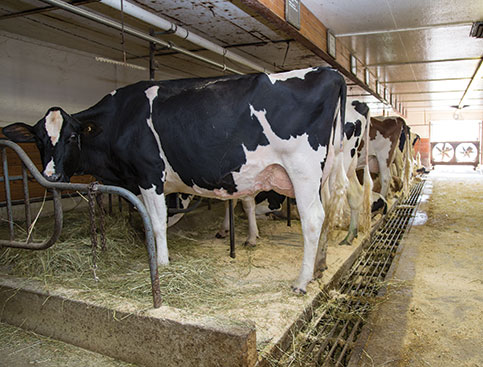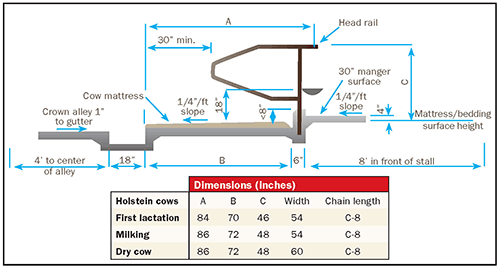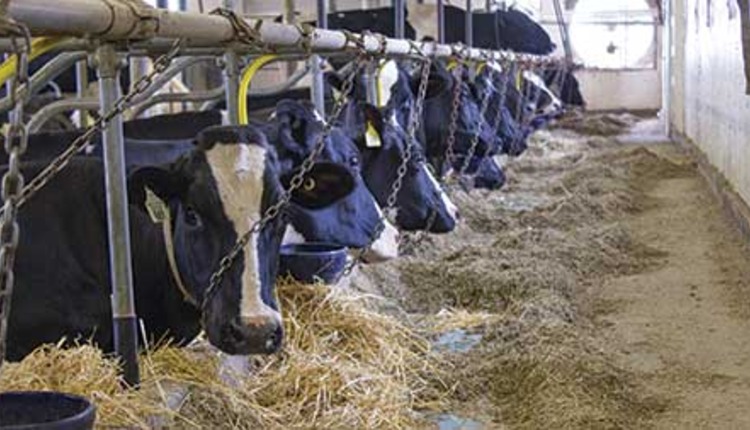The authors are a master's student at the University of Calgary and an associate extension professor at the University of Kentucky, respectively.

Barn design and stall dimensions contribute to a functional and efficient tie stall. Size stalls to meet the needs of your first-lactation heifers, older milking animals and dry cows.
Understanding the spatial requirements of a dairy cow is crucial when designing or upgrading a tie stall facility. Dairy cows devote a majority of their day to lying and resting. Disrupting this natural behavior can have negative effects on production and welfare. Stall design is crucial to encourage cows to lie down correctly and ensure that they are able to stand up in accordance with their natural behaviors. Due to size variations, breed is an important factor when calculating proper dimensions. It is recommended that farmers take measurements of their cows for more accuracy.
Unlike freestall facilities, tie stall barns offer the ability to create sections with different sized stalls for cows in various stages of life. There should be stalls designed specifically for first-lactation heifers, milking cows and dry cows. This is beneficial for cow welfare, cleanliness, labor and general management practices. The diagram provided by the Ontario Ministry of Agriculture and Food depicts recommended stall dimensions for all three different stall sizes.
Stall length refers to the bed in the tie stall. Length is determined by the space a cow occupies when she is lying down, including the space from her knee to her tail. This is often described as imprint length.
To find the proper length for the stall, or imprint length, rump height should be measured in inches. Once this height is obtained, it is multiplied by 1.2. For example, if a cow has a rump height of 60 inches, the bed length should be 72 inches (60 x 1.2 = 72). Stall length should be considered for all three stall types. There should be no difference in length for dry cows and milking cows, but on average the stalls are 2 inches shorter for first-lactation heifers due to differences in size.
Traditionally, stall width was determined by imprint width. This was calculated by multiplying the hook bone width by 2. For a mature Holstein, this was typically 52 inches. Studies have shown that this width prevents cows from resting in other positions, reducing cow comfort and compromising animal welfare. It is now recommended that, for a mature Holstein, the minimum width should be 54 inches.
Studies have shown that, when cows were placed in wider stalls, they took full advantage of the extra space. Width should also be considered for all three different stall types. First-lactation heifers and lactating cows should have the same minimum stall width of 54 inches. Dry cows, or special needs' cows, should have a stall width that is 6 inches wider than the other stalls.

Stall dividers, or loops, should be installed as boundaries. Loops will help dictate how the cow stands, where the cow defecates, and how the cow enters and exits the stall. Farmers must keep in mind milking procedures when installing the loops. Milkers should have enough space to work efficiently in-between the cows.
The tie rail, also known as the head rail, is located on the front end of the stall. This is where the chain on the cow is attached, and it also serves as the water line to all of the stalls on one side. The rail should be placed over the manger where the cow eats. This means that the tie rail should extend past the bed of the stall.
Proper tie rail placement is imperative for functionality of the stall. If this rail is not correct, cows will not stand in the stall properly. It may also prevent a cow from being able to lie down and rise naturally. This can lead to cleanliness issues, as well as potential injuries.
To calculate tie rail height, rump height is measured and multiplied by 0.8. For example, if a cow has a rump height of 60 inches, the tie rail should be installed 48 inches above the bed. Again, this should be adjusted for all three of the stall sizes. The tie rail height should be the same for milking cows and dry cows but is typically 2 inches shorter for first-lactation heifers.
The chain attaches the cow to the stall and also helps keep the cow in a proper location. The chain can have an effect on cow cleanliness. If the chain is too long, the cow may be able to lie in the gutter. A long chain may also result in an injury if it becomes wrapped around the cow's leg. If the chain is too short, natural lying behaviors can be disturbed, potentially causing neck lesions. Short chains may also reduce cleanliness, possibly causing the cow to defecate inside of the stall.
Again, it is essential to recognize a cow's natural behavior and encourage lying time. If the cow is prevented from lying or standing comfortably, the cow will be less likely to rest. In a study by Ceballos and colleagues, it was determined that a Holstein utilizes 10 feet of space, measured from the rump, to lunge forward when standing up. It is important to have an unobstructed, open area in front of the stall.
Proper barn design and stall dimensions are crucial for a functional and efficient tie stall barn. Cow comfort is very important in tie stall facilities for production, cow welfare and public perception. It is very important that the design of the facility is done carefully and that measurements of the cows are taken for accuracy.
Click here to return to the Animal Care E-Sources
150525_370

Understanding the spatial requirements of a dairy cow is crucial when designing or upgrading a tie stall facility. Dairy cows devote a majority of their day to lying and resting. Disrupting this natural behavior can have negative effects on production and welfare. Stall design is crucial to encourage cows to lie down correctly and ensure that they are able to stand up in accordance with their natural behaviors. Due to size variations, breed is an important factor when calculating proper dimensions. It is recommended that farmers take measurements of their cows for more accuracy.
Unlike freestall facilities, tie stall barns offer the ability to create sections with different sized stalls for cows in various stages of life. There should be stalls designed specifically for first-lactation heifers, milking cows and dry cows. This is beneficial for cow welfare, cleanliness, labor and general management practices. The diagram provided by the Ontario Ministry of Agriculture and Food depicts recommended stall dimensions for all three different stall sizes.
Size stalls to your cows
Stall length refers to the bed in the tie stall. Length is determined by the space a cow occupies when she is lying down, including the space from her knee to her tail. This is often described as imprint length.
To find the proper length for the stall, or imprint length, rump height should be measured in inches. Once this height is obtained, it is multiplied by 1.2. For example, if a cow has a rump height of 60 inches, the bed length should be 72 inches (60 x 1.2 = 72). Stall length should be considered for all three stall types. There should be no difference in length for dry cows and milking cows, but on average the stalls are 2 inches shorter for first-lactation heifers due to differences in size.
Traditionally, stall width was determined by imprint width. This was calculated by multiplying the hook bone width by 2. For a mature Holstein, this was typically 52 inches. Studies have shown that this width prevents cows from resting in other positions, reducing cow comfort and compromising animal welfare. It is now recommended that, for a mature Holstein, the minimum width should be 54 inches.
Studies have shown that, when cows were placed in wider stalls, they took full advantage of the extra space. Width should also be considered for all three different stall types. First-lactation heifers and lactating cows should have the same minimum stall width of 54 inches. Dry cows, or special needs' cows, should have a stall width that is 6 inches wider than the other stalls.

Stall dividers, or loops, should be installed as boundaries. Loops will help dictate how the cow stands, where the cow defecates, and how the cow enters and exits the stall. Farmers must keep in mind milking procedures when installing the loops. Milkers should have enough space to work efficiently in-between the cows.
Tie rail keeps cows aligned
The tie rail, also known as the head rail, is located on the front end of the stall. This is where the chain on the cow is attached, and it also serves as the water line to all of the stalls on one side. The rail should be placed over the manger where the cow eats. This means that the tie rail should extend past the bed of the stall.
Proper tie rail placement is imperative for functionality of the stall. If this rail is not correct, cows will not stand in the stall properly. It may also prevent a cow from being able to lie down and rise naturally. This can lead to cleanliness issues, as well as potential injuries.
To calculate tie rail height, rump height is measured and multiplied by 0.8. For example, if a cow has a rump height of 60 inches, the tie rail should be installed 48 inches above the bed. Again, this should be adjusted for all three of the stall sizes. The tie rail height should be the same for milking cows and dry cows but is typically 2 inches shorter for first-lactation heifers.
The chain attaches the cow to the stall and also helps keep the cow in a proper location. The chain can have an effect on cow cleanliness. If the chain is too long, the cow may be able to lie in the gutter. A long chain may also result in an injury if it becomes wrapped around the cow's leg. If the chain is too short, natural lying behaviors can be disturbed, potentially causing neck lesions. Short chains may also reduce cleanliness, possibly causing the cow to defecate inside of the stall.
Account for lunge space
Again, it is essential to recognize a cow's natural behavior and encourage lying time. If the cow is prevented from lying or standing comfortably, the cow will be less likely to rest. In a study by Ceballos and colleagues, it was determined that a Holstein utilizes 10 feet of space, measured from the rump, to lunge forward when standing up. It is important to have an unobstructed, open area in front of the stall.
Proper barn design and stall dimensions are crucial for a functional and efficient tie stall barn. Cow comfort is very important in tie stall facilities for production, cow welfare and public perception. It is very important that the design of the facility is done carefully and that measurements of the cows are taken for accuracy.
150525_370









